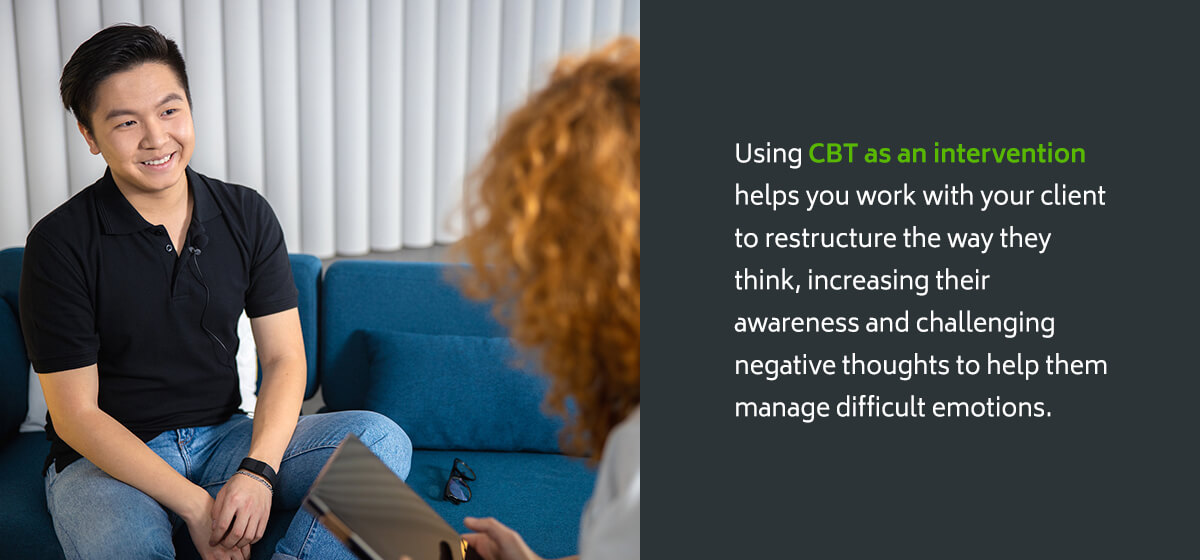Blog > Treatment Strategies > Therapeutic Interventions for Mental Health Progress Notes
Therapeutic Interventions for Mental Health Progress Notes
Need practical guidance for documenting therapeutic interventions in your progress notes? This guide offers clear strategies you can apply right away. You’ll learn common techniques like cognitive restructuring, mindfulness, anger management, and communication training, with tips on how to chart them effectively. You can also download a free PDF with ready-to-use intervention phrases to save time and support clinical accuracy.

Last Updated: November 2, 2025

Clear documentation of therapeutic interventions is essential for quality care, continuity, and insurance compliance. As therapy techniques and modalities continue to evolve, clinicians need simple and accurate ways to capture what happens in each session. Choosing the right intervention is important; documenting it properly is just as critical in behavioral health.
What Are Therapeutic Interventions in Progress Notes?
A therapeutic intervention is a strategy that therapists, counselors, and other behavioral health professionals can use to help clients who may be struggling to fully engage in their treatment. In some cases, the patient may be unable to help themselves or engage in self-destructive behavior that concerns their family members and loved ones, so the intervention may be confrontational in nature. In other cases, the patient may agree to work on a unique intervention that specifically works for their needs and come to a solution with their therapist.
There are many different types of potential therapeutic interventions therapists can use as a tool to help manage certain behaviors, conditions, or illnesses, such as:
- Eating disorders
- Substance abuse/addiction
- Dangerous sexual habits
- Dementia
- Stress-related illness
- Difficulty adhering to prescribed medication
- Mood disorders that make the patient a danger to themselves
- Self-harming
- Suicidal threats, risks, or behaviors
- Other life-threatening behaviors.
A therapeutic intervention can also be a deliberate decision or action that you may take with your client during the course of a regular session. The goal of these interventions is to provide a non-threatening, positive effect on the patient experiencing distress. Interventions can help modify behaviors that interfere with their well-being and safety.
Although therapeutic interventions can sometimes be staged and planned, they can also be any action that will help the patient enact positive change in a safe and structured manner. This means you can have a peaceful, respectful confrontation with your patient about their behavior and even employ a blend of techniques to meet their unique needs.
Need Quick Ideas for Therapy Interventions?
Download our free guide with evidence-based techniques, client-centered phrases, and tools for more effective, engaging sessions.
Commonly Used Therapy Interventions
Mental health professionals frequently rely on evidence-based interventions tailored to the client’s diagnosis and needs. Common therapeutic interventions include:
Cognitive Behavioral Therapy (CBT): Cognitive restructuring, behavioral activation, exposure tasks.
Dialectical Behavior Therapy (DBT): Mindfulness training, distress tolerance, and emotion regulation.
Motivational Interviewing (MI): Readiness rulers, decisional balance, and affirming statements.
Psychoeducation: Teaching clients about diagnoses, symptoms, and coping strategies.
Supportive Therapy: Active listening, empathy, validation, and reality testing.
ICANotes provides prebuilt intervention templates for many modalities, which clinicians can personalize based on the therapeutic orientation and client response.
Examples of Therapeutic Interventions to Use in Progress Notes
As a therapist, it's important to know what therapeutic interventions you may use with your patients and what mental health conditions they can help with. If you decide to use any of these interventions, it may be useful to document how the client appears when they enter the session versus when they leave; a brief description of what you discussed, and how the client is progressing toward their goals. Here are some therapeutic intervention examples you may want to try using in your therapy notes.
1. Identifying Triggers
Helping clients recognize emotional, behavioral, or environmental triggers is an essential first step in many treatment plans. This intervention increases client self-awareness and supports early intervention strategies. Triggers might include people, places, situations, or internal cues that contribute to distress or undesired behaviors.
Example of Therapeutic Intervention: “Client explored recent episodes of anxiety and identified social settings as a recurring trigger; developed awareness strategies for early signs.”

2. Cognitive Restructuring
Cognitive behavioral therapy (CBT) is a common and effective type of psychological treatment you can use to help with a wide range of mental health problems, such as anxiety disorders, depression, eating disorders, and other types of severe mental illness.
Using CBT as an intervention helps you work with your client to restructure their thinking, increasing their awareness, and challenging negative thoughts to help them manage difficult emotions.
Example of Therapeutic Intervention: “Guided client through identification of distorted thoughts and practiced cognitive reframing; client was able to generate 2 alternative thoughts in response to automatic negative beliefs.”
3. Anger Management
Everyone experiences anger during their lives, but certain people may display severe anger issues as a result of trauma or other mental health conditions. In some cases, your patient's anger may even cause them to become a danger to themselves and others.
Anger management as an intervention focuses on helping patients recognize that though anger is a normal, healthy emotion, expressing it in unhealthy ways can lead to additional problems. You can use this intervention to help your patient manage their anger and find healthier ways of self-expression.
Example of Therapeutic Intervention: “Reviewed anger cues and introduced coping strategies (deep breathing, pause technique); client reflected on recent conflict and identified early signs of escalation.”
4. Imagery Training
You may have one or more patients who struggle with chronic stress, anxiety, or other conditions that make it difficult for them to relax. In this case, an imagery or relaxation training intervention can be useful. Have your client practice visualizing themselves in a peaceful, relaxed setting, such as their favorite place or a location they've always wanted to travel to.
Instruct them to focus on the sensory details of the experience, such as what they might see, feel, hear, and smell. Some patients may also benefit from closing their eyes and envisioning themselves meeting their goals, which can help motivate them to engage in therapy.
Example of Therapeutic Intervention: “Facilitated guided imagery exercise focused on beach setting; client reported reduced muscle tension and increased sense of calm by session end.”
5. Mindfulness
Often associated or combined with CBT training, mindfulness as an intervention strategy may be particularly effective for patients who struggle with anxiety, depression, suicidal ideation, or intrusive thoughts.
As the name suggests, mindfulness promotes being more aware and engaged in the present moment rather than losing oneself to one's thoughts or spiraling about hypothetical situations. Some examples of mindfulness therapy include breathing exercises, meditation, gratitude affirmations, or self-compassion practices.
Example of Therapeutic Intervention: “Practiced present-moment awareness using 5-4-3-2-1 grounding technique; client expressed improved ability to disengage from racing thoughts.”
6. Communication Training
One of the most critical parts of therapy is teaching your patient how to effectively communicate their feelings and experiences in a healthy way. You may decide to use a communication training intervention on a patient if they are using unhealthy coping mechanisms as a way of expressing themselves or struggling to connect with their partner and loved ones as a result of their mental health condition.
You can use this interpersonal therapy intervention technique to validate your patient while they are opening up, and use active listening to increase their comfort with communication. You may also increase the number of open-ended questions you ask to keep the dialogue going.
Example of Therapeutic Intervention: “Used role-play to model assertive communication; client practiced using I-statements to express emotional needs and reported feeling more confident in future interactions.”
7. Problem-Solving Skills Training
An effective, universal intervention technique to keep in mind during your session is helping your client improve their problem-solving skills. This cognitive behavior intervention can be used for a wide range of people who struggle to address difficult life changes, handle conflict, overcome stressful events, or set boundaries with their loved ones.
You can apply this intervention using a 4-step process that includes assessing your patient's current approach to problem-solving, defining the problem they need to address, brainstorming and analyzing potential solutions, and implementing a realistic plan. The most important aspect of problem-solving skills training is to ensure your patient feels challenged yet equipped to follow through with this change.
Example of Therapeutic Intervention: “Worked through structured problem-solving model; client identified conflict with coworker, generated 3 options, and selected a plan to initiate resolution next week.”
Creative Therapy Techniques That Boost Client Engagement
Clinicians are increasingly integrating creative, somatic, and experiential therapy techniques into sessions to foster deeper engagement, emotional expression, and connection. These approaches are especially helpful for clients who may struggle with traditional talk therapy, such as children, trauma survivors, or those with limited verbal processing skills.
Below are examples of creative therapeutic interventions, along with note-ready documentation language you can adapt in your progress notes:
Art Therapy: Using visual media to express thoughts, emotions, or experiences that may be difficult to verbalize.
“Client completed visual timeline of traumatic events and discussed emotional responses.”
Movement Therapy: Incorporating the body to increase self-awareness, support regulation, or release tension.
“Used body scan and mindful walking to reduce dissociation and enhance grounding.”
Drama Therapy: Using role-play and theatrical techniques to process unresolved conflicts or explore identity.
“Facilitated role-play of confrontation scenario to help client express and regulate anger in a safe context.”
Music Therapy: Using music for emotional exploration, self-expression, or cognitive stimulation.
“Explored emotional regulation by analyzing song lyrics related to grief and identified coping strategies.”
Laughter or Humor Therapy: Employing intentional laughter or play to improve mood and reduce anxiety.
“Introduced laughter-based breathing exercise to release physical tension and shift client’s affect.”
These interventions may not be suitable for every setting or client population, but when applied, they should be clearly described in your documentation. Including the clinical intent, client response, and therapeutic benefit helps ensure transparency and supports both treatment planning and compliance.

Clinical Intervention Words to Use in Progress Notes
Choosing the right clinical language is essential for writing clear, effective, and defensible mental health progress notes. These words communicate the clinician’s therapeutic actions and the client’s engagement in a way that supports both treatment outcomes and insurance documentation.
To make your documentation more efficient, it helps to organize these intervention words into functional categories. Below are commonly used clinical terms grouped by intent, with examples of when to use them in your behavioural health documentation.
Engagement and Support
Use these words when the goal is to build rapport, validate client experience, or offer emotional support.
Listened — Demonstrated active listening during client disclosure
Acknowledged — Recognized the client’s emotions or statements
Validated — Affirmed the client’s experience or emotional state
Affirmed — Reinforced the client’s strengths or insights
Encouraged — Supported client efforts or exploration
Supported — Provided emotional or practical support
Shared — Offered reflections or similar experiences for therapeutic modeling.
Cognitive and Emotional Processing
Use these terms when documenting insight-oriented or cognitive-behavioral interventions.
Clarified — Helped client reframe or better understand thoughts
Explored — Examined emotions, beliefs, or behaviors
Reflected — Offered therapeutic reflection to increase awareness
Challenged — Gently confronted distortions or maladaptive thoughts
Evaluated — Assessed the client’s thoughts, responses, or progress
Reviewed — Went over prior content, goals, or coping strategies
Discussed — Talked through presenting issues or interventions
Behavioral Intervention and Skill Building
These words align well with structured, skills-based, or goal-oriented therapy interventions.
Instructed — Taught coping strategies or techniques
Demonstrated — Modeled a behavior or skill in session
Practiced — Facilitated in-session rehearsal of new skills
Role played — Engaged in role-play for communication or conflict resolution
Planned — Developed or reviewed a treatment plan or goal
Reinforced — Strengthened previously learned strategies or behaviors
Set boundaries — Coached client on boundary-setting techniques
Crisis Management and Emotional Regulation
Use these when intervening during emotional escalation or distress.
De-escalated — Reduced acute emotional distress or agitation
Redirected — Shifted focus from maladaptive to adaptive response
Guided — Steered the client through regulation or grounding exercises
Facilitated — Led a therapeutic process or experiential activity
Provided — Offered psychoeducation, resources, or tools.
Collaboration and Progress Monitoring
These words are helpful when documenting the collaborative aspects of therapy and goal tracking.
Collaborated — Worked with the client to create solutions or insights
Developed — Built skills, treatment plans, or behavioral strategies
Introduced — Brought in a new technique, concept, or goal
Assisted client in — Helped client engage in a specific task or process
Examined — Took a closer look at recurring thoughts, patterns, or experiences.
Frequently Asked Questions
Write Effective Progress Notes with ICANotes EHR Software
No matter which intervention you use for your patient, it's important to keep each of your sessions well-documented so you can see how they are progressing and adjust their treatment plan as needed. However, spending hours on documentation can interrupt your flow and prevent you from spending as much time as possible with your patients.
With ICANotes, you can efficiently and effectively document your interventions in your progress notes with our therapy note-writing templates and assessment tools. ICANotes is the premier mental health EHR, providing you with an intuitive, robust charting solution that meets all your needs and reduces the documentation burden, so you can focus on what matters most. Schedule a demo today or start your free trial to see how our solution can benefit your practice.
Start Your 30-Day Free Trial
Experience the most intuitive, clinically robust EHR designed for behavioral health professionals, built to streamline documentation, improve compliance, and enhance patient care.
- Complete Notes in Minutes - Purpose-built for behavioral health charting
- Always Audit-Ready – Structured documentation that meets payer requirements
- Keep Your Schedule Full – Automated reminders reduce costly no-shows
- Engage Clients Seamlessly – Secure portal for forms, messages, and payments
- HIPAA-Compliant Telehealth built into your workflow
Complete Notes in Minutes – Purpose-built for behavioral health charting
Always Audit-Ready – Structured documentation that meets payer requirements
Keep Your Schedule Full – Automated reminders reduce costly no-shows
Engage Clients Seamlessly – Secure portal for forms, messages, and payments
HIPAA-Compliant Telehealth built into your workflow
Dr. October Boyles is a distinguished healthcare professional with extensive expertise in behavioral health, clinical leadership, and evidence-based care delivery. With a Doctor of Nursing Practice (DNP) from Aspen University and advanced degrees in nursing, she brings a depth of clinical knowledge and a passion for improving mental health care services.













